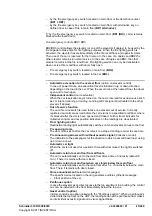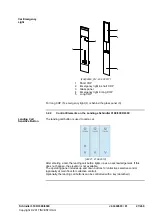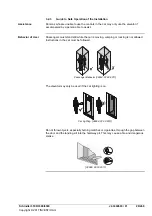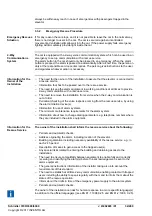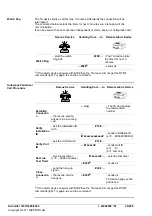
Schindler 3100/3300/6300
J 43402603 / 01
32/269
Copyright © 2017 INVENTIO AG
always be within easy reach in case of emergencies with passengers trapped in the
elevator.
3.3.2
Emergency Rescue Procedure
Emergency Rescues
Situation
If for any reason the car stops, and it is not possible to leave the car in the normal way,
there is no danger to users in the car. The car is secured against uncontrolled
movements. Ventilation slits allow air into the car. If the power supply fails, emergency
lighting will immediately provide light inside the car.
2-Way
Communications
System
The car is equipped with a 2–way voice communication system, which can be used in an
emergency to set up communication with a rescue service.
The alarm button in the car should only be pressed in an emergency. When the alarm
button is pressed, the alarm is passed on automatically. After a short time, the person on
duty at the responsible service center replies. The person gives instructions to the user,
and organizes whatever action is necessary.
Information for the
Owner of the
Installation
–
The need for the owner of the installation to assure that the elevator is connected to
a rescue service.
–
Information that has to be passed over to the rescue service.
–
The need to keep the alarm equipment in working conditions at all times to provide
2-way communication with a rescue service.
–
The need to remove the installation from service when the 2-way communication is
out of order.
–
Periodical checking of the voice response coming from the rescue service, by using
the alarm initiation device(s).
–
Information for use of alarm systems.
–
The minimum maintenance requirements for the alarm system.
–
Information about how to change dialing parameters e.g. telephone numbers where
they are included in the alarm equipment.
Information for the
Rescue Service
The owner of the installation shall inform the rescue service about the following:
–
Periodic and automatic checks.
–
Address originating the alarm, including location of the elevator.
–
Building organization including necessary availability of the rescue service, e.g. in
each 24 h period.
–
Description of means to gain access to the trapped user(s).
–
Any special risks related to entering the building and obtaining access to the
installation.
–
The need to ensure compatibility between equipment to enable fully and correctly
receiving and identifying the alarm(s) before the acknowledgement is sent to the
alarm equipment.
–
The general instructions information of the installer taking also into account the
requirements of this standard.
–
The need to establish at all time 2-way communication enabling contact with trapped
users including the ability to speak regularly with them and to inform them about the
status of the rescue operation.
–
Inform about the limits in time of the emergency power supply to the alarm system.
–
Periodic and automatic checks.
The owner of the installation can ask for human response in a more specific language(s)
in addition to the official language(s) (see EN 81-1:1998,0.2.5 and EN 81-2:1998, 0.2.5).






